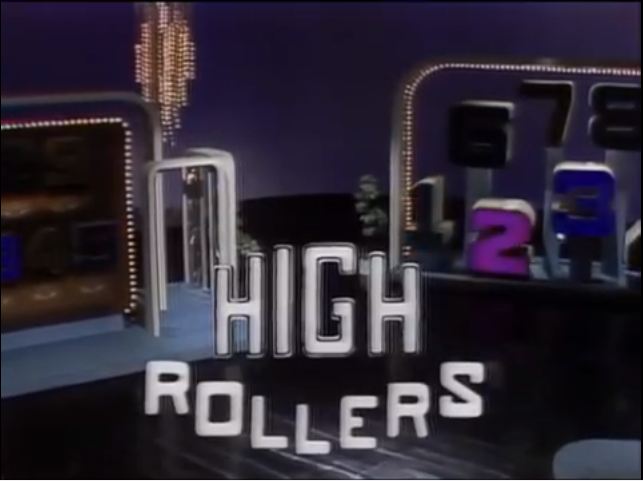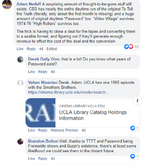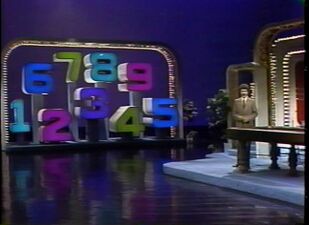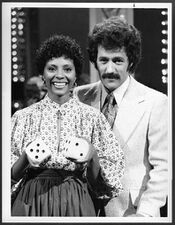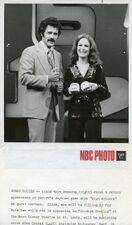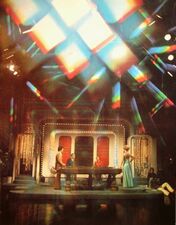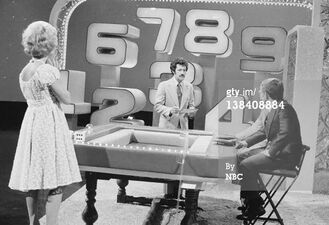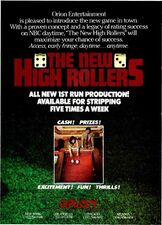High Rollers (partially found Alex Trebek game show; 1974-1976; 1978-1980): Difference between revisions
Comedyfan74 (talk | contribs) mNo edit summary |
Comedyfan74 (talk | contribs) mNo edit summary |
||
| Line 12: | Line 12: | ||
During the last seven weeks of the show's first run in 1976, the front game was changed to where the numbers are now on a 3×3 grid and concealed a picture of a famous person. After each good roll, the contestant has a chance to guess the celebrity the board is concealing. If Ruta rolls a bad number, control passes to the other contestants and they get a chance to guess the celebrity. A correct guess wins the contestant all the prizes they uncovered on the board. If neither contestant guesses correctly, Alex would give clues about the celebrity until the first contestant buzzes in with the correct answer. | During the last seven weeks of the show's first run in 1976, the front game was changed to where the numbers are now on a 3×3 grid and concealed a picture of a famous person. After each good roll, the contestant has a chance to guess the celebrity the board is concealing. If Ruta rolls a bad number, control passes to the other contestants and they get a chance to guess the celebrity. A correct guess wins the contestant all the prizes they uncovered on the board. If neither contestant guesses correctly, Alex would give clues about the celebrity until the first contestant buzzes in with the correct answer. | ||
When the show came back in 1978, the board consists of three columns with random numbers and each column | When the show came back in 1978, the board consists of three columns with random numbers (3 in each column) and each column having one or more prizes that the contestant can win if they knock out the last number in the respective column. There were also "hot columns" in which a column could be knocked out with one roll that the three numbers in the column add up to. However, the contestant has to win the game in order to keep the prizes. This happens twice (three if a tie occurs) and the first person to win two rounds will go on to play the big numbers. | ||
In the big numbers, the winning contestant has to eliminate all nine numbers in order to win $10,000. Rules are the same as they were in the main game but if Ruta or the contestant rolls a number that can't be added with the available numbers on the board, the game ends and the contestant gets $100 for each number eliminated. If all nine numbers are eliminated, the contestant wins $10,000. | In the big numbers, the winning contestant has to eliminate all nine numbers in order to win $10,000. Rules are the same as they were in the main game but if Ruta or the contestant rolls a number that can't be added with the available numbers on the board, the game ends and the contestant gets $100 for each number eliminated. If all nine numbers are eliminated, the contestant wins $10,000. | ||
Revision as of 16:18, 29 September 2023
High Rollers was a game show based on the dice game "Shut the Box" that ran on NBC between 1974 to 1980 and in Syndication from 1987 to 1988. The show was created by Merrill Heatter and Bob Quigley[1] who previously created Hollywood Squares and Gambit and was hosted by the late Alex Trebek from 1974 to 1980 and then by Wink Martindale from 1987 to 1988. Due to the show airing at a time where reusing tapes was a common practice, most of the show's runs on NBC are lost.
Format
The show consists of two contestants and a board of numbers from 1 to 9. The object of the game is to eliminate all nine numbers on the board to win. In order to do that you have to buzz in with the correct answer to a question asked by Alex and the hostess (Ruta Lee) would roll two dice and whatever number they add up to, the player in control has to eliminate numbers from the board that add up to the number that Ruta rolled. Behind all nine numbers are prizes, if you knock out a number, you get that prize (but to win the prizes you got, you have to win the round). If Ruta rolls a number that can't be added with the available numbers on the board, you lose and your opponent wins the round. If Ruta rolls a double (a number that both dices land on) you get an insurance marker, where if Ruta rolls a number that can't be added with the available numbers on the board, you get another chance.
During the last seven weeks of the show's first run in 1976, the front game was changed to where the numbers are now on a 3×3 grid and concealed a picture of a famous person. After each good roll, the contestant has a chance to guess the celebrity the board is concealing. If Ruta rolls a bad number, control passes to the other contestants and they get a chance to guess the celebrity. A correct guess wins the contestant all the prizes they uncovered on the board. If neither contestant guesses correctly, Alex would give clues about the celebrity until the first contestant buzzes in with the correct answer.
When the show came back in 1978, the board consists of three columns with random numbers (3 in each column) and each column having one or more prizes that the contestant can win if they knock out the last number in the respective column. There were also "hot columns" in which a column could be knocked out with one roll that the three numbers in the column add up to. However, the contestant has to win the game in order to keep the prizes. This happens twice (three if a tie occurs) and the first person to win two rounds will go on to play the big numbers.
In the big numbers, the winning contestant has to eliminate all nine numbers in order to win $10,000. Rules are the same as they were in the main game but if Ruta or the contestant rolls a number that can't be added with the available numbers on the board, the game ends and the contestant gets $100 for each number eliminated. If all nine numbers are eliminated, the contestant wins $10,000.
Cancellation
High Rollers replaced The Wizard of Odds (also hosted by Alex Trebek[2]) in NBC's daytime lineup and did better than the latter in the ratings and made Alex Trebek a household name. However, NBC moved the show from its 11 a.m. time slot[3] to 12pm[4] and again to 10:30 am [5], which turned away many viewers and a clear sign that NBC had no faith in the show. High Rollers would air its final episode for the first time on June 11, 1976, a new version would arrive on NBC on April 24, 1978. This time NBC didn't change its time slot and like its previous run[6], did very well in the ratings. However to make room for the 90-minute "The David Letterman Show", the show was one of three shows that got cancelled on June 20, 1980 (the other two being Chain Reaction and The Hollywood Squares[7][8]). The David Letterman Show flopped hard and was gone by October 24, 1980, and High Rollers would never return to NBC.
Availability
According to a comment by game show author Adam Nedeff in 2019, the tapes for the show's first NBC run still exist, but the trouble of "closing a deal for the tapes and converting them to a usable format and figuring out if they'll generate enough revenue to offset the cost of the deal and conversation" is what's stalling a release of the show. A clip of the Big Numbers round would surfaced on YouTube on August 19, 2016, the same day the July 4, 1975 episode would surface (the first time since 1976 that any material of its first run would resurface). Audio tapes of 13 episodes are confirmed to exist though none of them have been uploaded online[9]. It's unknown what happened to the tapes of the show's second run on NBC. Only 10 of it's 559 episodes can be found today.
Gallery
Videos
Pictures
External Links
References
- ↑ David Schwartz, Steve Ryan and Fred Wostbrock, The Encyclopedia of TV Game Shows, Third Edition., Checkmark Books, 1999, p. 92
- ↑ https://archive.org/details/ultimatetvgamesh01ryan
- ↑ https://www.reddit.com/media?url=https%3A%2F%2Fi.redd.it%2Fits-a-monday-in-august-1975-what-game-shows-are-you-v0-rke31l9ezpgb1.jpg%3Fs%3D2371db4841c5f8c139eb0e86cf257d11bda1523d
- ↑ http://daytimetvarchive.com/grids/1975.html
- ↑ http://daytimetvarchive.com/grids/1976.html
- ↑ http://daytimetvarchive.com/grids/1978.html
- ↑ https://time.com/3858346/david-letterman-infinite-jester/
- ↑ https://www.youtube.com/watch?v=__41TGhLuns&ab_channel=blanquepage
- ↑ https://atvaudio.com/ata_search.php?keywords=HIGH+ROLLERS
